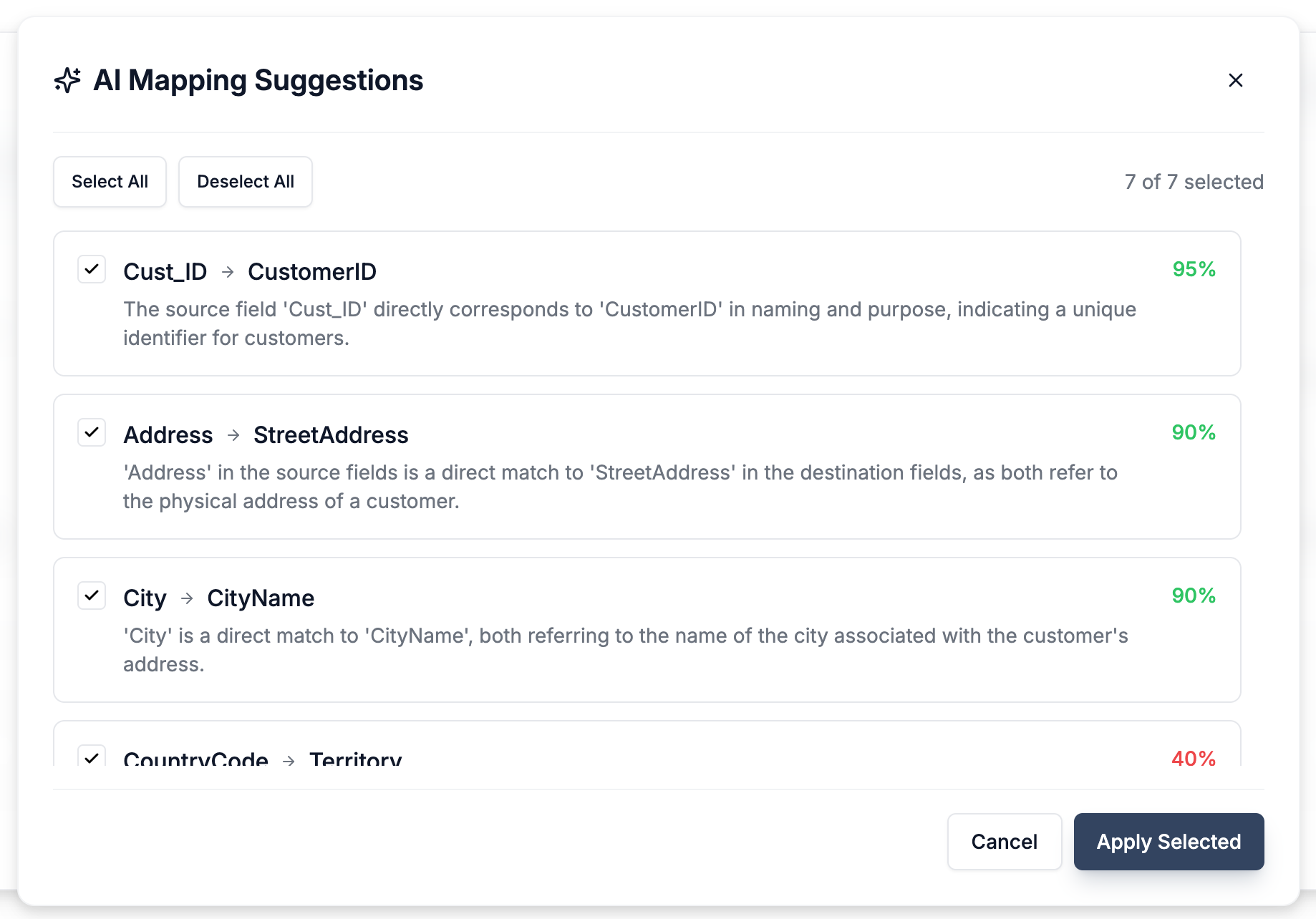
Loading...
Loading...

Data migration and client onboarding. For implementation teams, these processes often mean wrestling with messy client data in CSV, Excel, or JSON formats. Hours melt away manually mapping fields, deciphering cryptic column headers, and painstakingly building transformation logic in spreadsheets or complex scripts. It's tedious, error-prone, and a major bottleneck to getting projects live.
Traditional approaches fall short. Manual mapping is slow and invites mistakes. Python scripts require coding expertise and become difficult to maintain ("knowledge silos"). Enterprise ETL tools are often overkill, expensive, and lack the agility needed for diverse client files. Simple CSV importers handle basic uploads but crumble when faced with the real-world business rules and transformations essential for successful data onboarding. They lack the features to automate field mapping or handle AI data transformation.
What if you could leverage AI data mapping tools to automate the most time-consuming parts of this process? Imagine translating plain English requirements directly into accurate transformation logic, all within an intuitive, visual platform designed for implementation specialists.
DataFlowMapper was built to bridge this gap, providing powerful, visual data transformation. Now, integrated AI capabilities directly target the core challenges of data mapping and logic creation, helping you automate data migration with AI where it matters most.
Let's explore how specific AI data mapping tools within DataFlowMapper streamline your workflow:
Want to see DataFlowMapper's AI Copilot in action? Click here to watch our guide.
You receive a client's CSV file with dozens, maybe hundreds, of columns. Your target system requires a specific structure. Some names align, others are variations ('CustID' vs. 'Customer_ID'), and some require mapping multiple source fields to one destination. Manually connecting these dots is a recipe for fatigue and errors.
Benefit: Dramatically reduces manual mapping time, minimizes typos and oversight errors, and frees you to focus on the truly complex or ambiguous mappings. This is a core feature for anyone looking to automate field mapping.
 Fig: AI instantly suggests mappings between source and destination fields.
Fig: AI instantly suggests mappings between source and destination fields.
AI suggestions accelerate individual field mapping, but what about setting up the entire transformation based on a set of business requirements? How can you automate data transformation rules across the whole file efficiently?
Benefit: A massive time-saver for initial mapping setup, especially with wide or complex files. It translates your high-level requirements into a functional, near-complete mapping file almost instantly, providing a powerful starting point for refinement. This significantly improves how AI can improve data mapping efficiency.
This is where many projects hit a wall. You need to implement specific business rules: "If 'TransactionType' is 'REFUND' and 'DaysSincePurchase' < 60, calculate 'RestockFee' as 'Amount' * 0.15, else 0." Or, "Validate that 'PostalCode' matches the format for the given 'Country'." Building this reliably in Excel is fragile, and scripting requires developer time. How can you generate Python logic from English or create AI data validation assist?
Benefit: This makes sophisticated AI transformation rules and validation accessible, even without deep coding knowledge. It dramatically speeds up logic creation, reduces syntax errors, and provides an excellent, editable foundation. It answers the question: how can AI improve the accuracy and efficiency of our data onboarding process?
DataFlowMapper's AI capabilities utilize advanced Natural Language Processing (NLP) and machine learning models trained specifically for the domain of data transformation and onboarding. The system understands common data patterns, field naming conventions, typical business logic structures, and how to translate human language instructions into the specific functions and syntax used within the DataFlowMapper platform. This ensures the generated mappings and logic are not just suggestions, but directly usable configurations.
Integrating these specific AI data mapping tools directly into the transformation workflow delivers tangible benefits:
Stop letting manual data wrangling slow down your projects. Leverage AI data onboarding solutions designed for the real-world challenges implementation teams face.
Ready to experience the efficiency of AI-powered data mapping and logic generation?